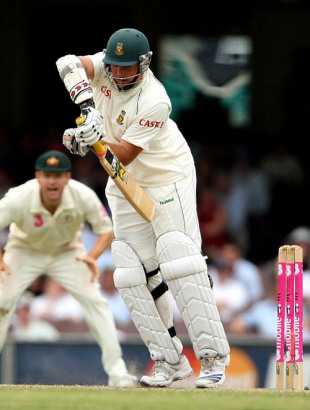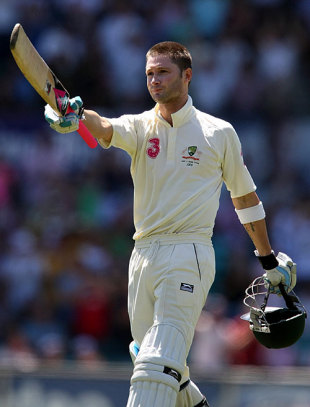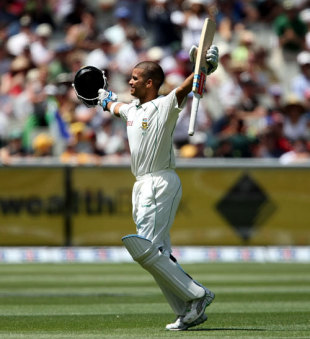Australia v South Africa 2008-09
Chloe Saltau
Test matches (3): Australia 1, South Africa 2
One-day internationals (5): Australia 1, South Africa 4
Twenty20 internationals (2): Australia 2, South Africa 0

|
|||
|
Related Links
News : Opener Warner blasts in to national scene
Feature : The bravest man in world cricket Peter Roebuck : A triumph beyond sport News : An empire in disarray Feature : The South African Mr Cricket Players/Officials:
Hashim Amla
| Michael Clarke
| AB de Villiers
| Jean-Paul Duminy
| Mitchell Johnson
| Graeme Smith
| Dale Steyn
| David Warner
Series/Tournaments:
South Africa tour of Australia
Teams:
Australia
| South Africa
|
|||
There are few things Australians like to celebrate as much as a cricket team that wallops every opponent, but one of them is a sportsman who plays when hurt. By the end of a disorientating summer, they could no longer count on a dominant Test side, but had warmed to a square-jawed South African who led his country to a famous series victory and was so injured by the end of it that he could not even lift the trophy. Defeating Australia 2-1 in their own back yard, a place so hostile that no visiting team had won a series there for 16 years, ranked alongside the 1995 Rugby World Cup victory among South Africa's proudest sporting achievements, and the contribution of captain Graeme Smith - the man of the series - was inspirational.
Smith made 326 runs at 65.20 despite chronic pain in his right elbow, and was dismissed for less than 48 just once. Only after the other hand was broken at the SCG did he consent to treatment, dashing to Melbourne to have his own blood injected into the elbow joint, the benefits of which were undone when he returned at No. 11 and fought unsuccessfully to save the Third Test. It was a fitting finale to a series in which both tails wagged ferociously, leading to dramatic changes of momentum in each match.
The most stunning example of this was the 180-run stand for the ninth wicket between Jean-Paul Duminy and Dale Steyn at Melbourne, which provided Australia's darkest day and won South Africa the series. Both sides lacked a quality spinner to snuff out tails. Overall, Australia's last four wickets contributed 38% of their runs per innings when everyone was required to bat; for South Africa, it was 35%.
Australia's thrilling win at Sydney meant they clung on to the No. 1 Test ranking craved by South Africa, but only notionally and for the time being. While the scale of Australia's defeats in the first two Tests did not do justice to the compelling nature of the contest between a vulnerable champion and an ambitious challenger, those who saw South Africa breeze to 414 at Perth or witnessed Australia's spectacular unravelling from a winning position at Melbourne knew in their hearts that the balance of power had changed.
All in Australian cricket came under attack and, while Ricky Ponting pleaded with the public to be patient with his evolving team, the chairman of selectors Andrew Hilditch was photographed by a Sunday newspaper walking his dog on an Adelaide beach at the precise moment Matthew Hayden was fighting for his career on the opening morning at the SCG. It was not a good look.

|
|||
South Africa, meanwhile, were settled, well prepared, and coming off a successful year. They arrived in Perth ten days before the First Test with three batsmen who had already compiled 1,000 Test runs in the calendar year, the world's outstanding paceman in Steyn, and a secret weapon - the former England coach Duncan Fletcher, a short-term consultant whose experience in toppling Australia in the 2005 Ashes was intended to give them an edge.
Both teams were hit by injuries to critical players before the series began. But while Duminy stepped seamlessly into the breach created by a thumb injury to the gritty Ashwell Prince to become the discovery of the tour, Australia could not have anticipated how sorely Stuart Clark would be missed when he was forced to return to Sydney on the eve of the First Test for surgery on the right elbow that had been troubling him for months. The tourists had regarded the dependable seamer Clark as the main danger, mindful of the hold he had established with 20 wickets in his debut series against them in South Africa in 2005-06.
Without him, the yawning hole where Shane Warne used to be seemed deeper and blacker than ever. Attacking spinner Jason Krejza possessed incredible self-belief and a dangerous off-break - like the lovely, drifting delivery that spun back and did for Hashim Amla at Perth - but he was incapable of building pressure, and became the first bowler to concede more than 100 runs in each of his first four Test innings. It was a trend Australia could not afford to continue, and Krejza was discarded for the remaining two Tests in favour of Nathan Hauritz, who displayed commendable control but could not pose more than a passing threat on a wearing wicket in Sydney.
The unforgiving schedule - condensed to three weeks to accommodate the inaugural Twenty20 Champions League, which was later cancelled because of the Mumbai terror attacks - afforded little time for players to recover between games, and by the end of the Second Test Clark had been joined on the sidelines by Brett Lee (foot and ankle) and all-rounders Andrew Symonds (knee) and Shane Watson (back).
Amid the injury chaos, attention turned to Australia's embattled selectors. Smith, who on his previous visit to Australia had rubbed the locals up the wrong way with his headline-grabbing statements, held his tongue until the series was won, but could not resist the ultimate taunt when Doug Bollinger was chosen to replace Lee ahead of Ben Hilfenhaus, who was already in the squad. It was, Smith said, suppressing a smile, England-like. "It reminds me a bit of the England tour, when they carried [Chris] Tremlett around the country and then picked [Dandenong roof-tiler Darren] Pattinson at Headingley. From our perspective it just seemed that naturally Hilfenhaus would come in. There's obviously a little bit of uncertainty there… We'll take that as a little feather in our cap on the trip."
Beyond the confusion in selection, evidence of Australia's decline could be seen in their failure to take 20 wickets in seven of 14 Tests in 2008, and in the ongoing struggles of two senior men, Hayden and Lee. The great opener, who in his prime personified Australia's domineering approach better than anyone, could not find a middle ground between fours and dot-balls, and made only 117 runs at 19.50 in the series. A few days later, the 37- year-old Hayden had an epiphany while picking tomatoes with his daughter, decided against pressing on to the 2009 Ashes, and retired. Lee, still jaded by illness, managed one wicket for 249 in the first two Tests, and broke down at the MCG. The spearhead's baton was passed to Mitchell Johnson, who blossomed with an unplayable spell to wipe out the South African tail at the WACA.
In the final half-hour of the series, a new Australian attack searched for a killer instinct, and a crowd draped in green and gold stood and applauded an opposition captain to the wicket. While Smith was embraced as a hero in two countries, Ponting had been given a sharp taste of life without so many of Australia's cricketing heroes against organised, quality opposition. He stood at the helm of a transitional team that had been humbled twice in three months, by India and South Africa, and had six weeks to regroup for the sequel - South Africa in their own country. He could only hope the consolation win at Sydney represented a new dawn.

|
|||
Daniel Brettig writes: For a few silly days in January 2009, David Warner was Australian cricket's equivalent of a reality television star. Plucked from the obscurity of a few domestic one-day games for New South Wales to play against South Africa in the Twenty20 match at the MCG, he hammered the most audacious 89, and in doing so added to the optimism the Australians had taken from victory in the dead final Test. Amid a wave of newspaper hysteria, and interviews with his mum, dad, brother, coaches and team-mates (everyone but the family dog seemed to have been consulted), he was drafted into the 50-over team after an injury to Michael Clarke. Unfortunately, Warner's time at the top was as fleeting as that of a Big Brother contestant, and by the end of the series he had wilted all too predictably for a quiet 22-year-old without a single first-class match to his credit.
Such a flimsy record brought Warner plenty of lenient judgment, but there were no such excuses for his team-mates, as they lost stature with each match against a South African one-day side every bit as transitional as the Australians. Johan Botha, who took over the captaincy while Graeme Smith recovered from breaking a hand at Sydney, was best remembered in Australia - if he was remembered at all - for being ruled a chucker during the 2005-06 tour, but on this visit he showed himself to be an astute and positive captain, as well as an off-spinner of growing confidence and considerable thrift. Behind him was a batting, bowling and fielding unit that shaded the Australians in every respect. Herschelle Gibbs, Hashim Amla, Jean-Paul Duminy, Jacques Kallis and A. B. de Villiers all made attractive runs, while Dale Steyn and Makhaya Ntini maintained their Test-match excellence both as wicket-takers and run-misers.
Yet the man of the series was the all-rounder Albie Morkel, who lifted the award without scoring a half-century or taking five wickets in an innings.He won it, instead, for some of the most punishing and influential short innings seen this side of Lance Klusener. Bashing 40 from 18 balls at Melbourne and 40 from 22 at Sydney, he got South Africa out of a couple of tight corners, and broke Australia's spirit in the process. Morkel contributed little to the final two matches, but by then the series script had been written.
For the Australians, there was precious little to be even vaguely pleased about. The loss of the No. 1 ranking occupied plenty of headline space, but of more concern was the sheer flatness of much of their cricket. Ricky Ponting was unable to inspire with the bat or in the field, and though Shaun Marsh provided some stability at the top of the order, the middle overs were wasted with remarkable consistency, and the batting powerplay seemed to be taken as an invitation to throw wickets away. All the bowlers delivered good spells, but none did it often enough to enjoy good series. Despite all that, at the end of the series several Australians were heard to say that they still considered themselves the best team in the world. No one was listening.
Match reports for
Tour Match: Western Australia v South Africans at Perth, Dec 11, 2008
Scorecard
Tour Match: Western Australia v South Africans at Perth, Dec 12-13, 2008
Scorecard
1st Test: Australia v South Africa at Perth, Dec 17-21, 2008
Report |
Scorecard
2nd Test: Australia v South Africa at Melbourne, Dec 26-30, 2008
Report |
Scorecard
3rd Test: Australia v South Africa at Sydney, Jan 3-7, 2009
Report |
Scorecard
1st T20I: Australia v South Africa at Melbourne, Jan 11, 2009
Report |
Scorecard
2nd T20I: Australia v South Africa at Brisbane, Jan 13, 2009
Report |
Scorecard
1st ODI: Australia v South Africa at Melbourne, Jan 16, 2009
Report |
Scorecard
2nd ODI: Australia v South Africa at Hobart, Jan 18, 2009
Report |
Scorecard
3rd ODI: Australia v South Africa at Sydney, Jan 23, 2009
Report |
Scorecard
4th ODI: Australia v South Africa at Adelaide, Jan 26, 2009
Report |
Scorecard
5th ODI: Australia v South Africa at Perth, Jan 30, 2009
Report |
Scorecard

